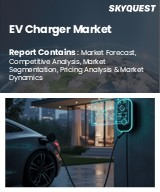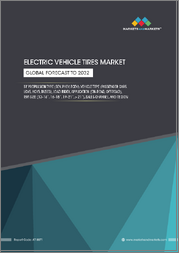
|
시장보고서
상품코드
1628093
차량 개조 시장 기회, 성장 촉진요인, 산업 동향 분석, 예측(2025-2034년)Vehicle Conversion Market Opportunity, Growth Drivers, Industry Trend Analysis, and Forecast 2025 - 2034 |
||||||
2024년에 59억 달러로 평가된 세계의 차량 개조 시장은 2025-2034년에 CAGR 9%로 성장할 것으로 예측됩니다.
이러한 성장을 가속하는 주요 요인 중 하나는 전기자동차(EV)에 대한 수요 증가입니다. 세계 각국 정부가 배출 규제를 강화하고 청정 에너지에 대한 인센티브를 제공함에 따라 소비자와 기업 모두 탄소 배출량을 줄일 수 있는 방법을 모색하는 추세가 강화되고 있습니다.
기존 내연기관차(ICE)를 전기자동차로 개조하는 개조는 신차 구매를 피하고 싶은 사람들에게 비용 효율적인 솔루션입니다. 개조 키트의 비용이 낮아지고 EV 기술이 향상됨에 따라 이러한 추세는 더욱 가속화되고 있습니다. 지속가능성과 친환경 교통수단을 추구하는 전 세계적인 움직임은 차량 개조 채택을 가속화하고 있습니다.
또 다른 주요 시장 성장 촉진요인은 차량 커스터마이징 및 개인화에 대한 수요 증가입니다. 소비자들은 성능, 고급스러움, 라이프스타일 등 다양한 이유로 개성 있는 차량을 소유하는 것에 대한 관심이 그 어느 때보다 높습니다. 이 때문에 레저용 차량(RV), 캠핑카 밴, 오프로드 차량 등의 개조가 인기를 끌고 있습니다. 개성에 대한 욕구가 커스텀 자동차 개조 시장을 촉진하고 있습니다.
| 시장 규모 | |
|---|---|
| 시작 연도 | 2024년 |
| 예측연도 | 2025-2034년 |
| 시작 금액 | 59억 달러 |
| 예상 금액 | 140억 달러 |
| CAGR | 9% |
이 시장은 크게 제품과 서비스 두 가지로 나뉘는데, 2024년에는 제품 부문이 시장 점유율의 65% 이상을 차지하고 2034년에는 80억 달러 이상에 달할 것으로 예상됩니다. 제품 부문의 우위는 모터, 배터리, 컨트롤러 등 내연기관차를 전기자동차로 전환하는 데 필수적인 컴포넌트에 기인합니다. 이러한 제품들은 전환 과정의 기초를 형성하고 시장 매출의 대부분을 주도하고 있습니다.
EV 기술이 발전하고, 신뢰할 수 있고 효율적인 개조 키트에 대한 수요가 증가함에 따라 각 업체들은 소비자의 요구를 충족시키기 위해 혁신을 거듭하고 있습니다. 이 제품 부문은 상용차와 승용차 모두에서 소비자들이 개조된 차량의 성능과 주행거리를 향상시키려는 수요로 인해 활발한 수요의 혜택을 누리고 있습니다.
차량 개조 시장은 승용차와 상용차로 세분화됩니다. 승용차 부문은 2024년 시장 점유율의 약 62%%를 차지할 것으로 예상되며, 이는 전 세계에서 승용차의 수가 많기 때문으로 분석됩니다. 많은 소비자들이 연료 비용과 배기가스 배출을 줄이기 위해 기존 차량을 전기자동차로 개조하여 새로운 전기자동차를 구매할 필요를 피하고 있습니다. 정부의 친환경 교통수단 지원 정책도 이러한 전환을 촉진하고 있으며, 특히 승용차의 경우 이러한 전환을 촉진하고 있습니다.
미국에서는 2024년 차량 개조 산업이 전 세계 매출의 75%를 차지할 것으로 예상되며, 2034년까지 30억 달러 이상에 달할 것으로 예상됩니다. 친환경 교통수단에 대한 높은 수요, EV의 활발한 보급, 정부의 인센티브 등이 이러한 성장에 기여하고 있습니다. 미국은 또한 자동차 애프터마켓 산업이 발달해 있고, EV 기술과 충전 인프라에 많은 투자를 하고 있으며, 시장의 선두주자로 자리매김하고 있습니다.
목차
제1장 조사 방법과 조사 범위
제2장 개요
제3장 업계 인사이트
- 에코시스템 분석
- 공급업체 상황
- 차량 개조 제품 프로바이더
- 서비스 프로바이더
- 제품 판매업체
- 최종사용자
- 이익률 분석
- 차량 개조의 비용 내역
- 기술 혁신 전망
- 주요 뉴스와 구상
- 규제 상황
- 영향요인
- 촉진요인
- 전기자동차(EV) 개조 수요 증가
- 자동차 커스터마이즈에 대한 관심의 증가
- 지속가능성을 촉진하는 정부의 장려책과 규제
- 개조 기술의 진보
- 업계의 잠재적 리스크 & 과제
- 고액의 초기 비용
- 규제와 인증 허들
- 촉진요인
- 성장 가능성 분석
- Porter의 산업 분석
- PESTEL 분석
제4장 경쟁 구도
- 서론
- 기업 점유율 분석
- 경쟁 포지셔닝 매트릭스
- 전략 전망 매트릭스
제5장 시장 추산·예측 : 유형별, 2021-2034년
- 주요 동향
- 제품
- 서비스
제6장 시장 추산·예측 : 차량별, 2021-2034년
- 주요 동향
- 승용차
- 해치백
- 세단
- SUV
- 상용차
- 소형 상용차(LCV)
- 대형 상용차(HCV)
제7장 시장 추산·예측 : 개조별, 2021-2034년
- 주요 동향
- 모빌리티 개조
- 상용차 개조
- 레크리에이션용 개조
- 기타
제8장 시장 추산·예측 : 지역별, 2021-2034년
- 주요 동향
- 북미
- 미국
- 캐나다
- 유럽
- 영국
- 독일
- 프랑스
- 스페인
- 이탈리아
- 러시아
- 북유럽
- 아시아태평양
- 중국
- 인도
- 일본
- 한국
- 뉴질랜드
- 동남아시아
- 라틴아메리카
- 브라질
- 멕시코
- 아르헨티나
- 중동 및 아프리카
- 아랍에미리트
- 남아프리카공화국
- 사우디아라비아
제9장 기업 개요
- Adventure Van Conversions
- BraunAbility
- Creative Mobile Interiors
- DIYev Inc.
- El Kapitan Conversion Vans
- Electric Classic Cars
- EV Source
- EV4U Custom Conversions
- Glampervan
- Green Shed Conversions
- HI PERFORMANCE ELECTRIC VEHICLE SYSTEMS
- Iconic EV
- Kisae Technology Inc.
- Legacy EV
- Midwest Automotive Designs
- OPTO Innovation
- retroEv
- Revamp Motors
- Zenith EV Conversions
- Zero Labs Automotive
The Global Vehicle Conversion Market, valued at USD 5.9 billion in 2024, is projected to grow at a CAGR of 9% from 2025 to 2034. One major factor driving this growth is the rising demand for electric vehicles (EVs). With governments around the world enforcing stricter emissions regulations and offering incentives for cleaner energy, both consumers and businesses are increasingly looking for ways to lower their carbon footprint.
Vehicle conversions, which involve upgrading traditional internal combustion engine (ICE) vehicles to electric power, are a cost-effective solution for those looking to avoid purchasing new vehicles. As the cost of conversion kits decreases and EV technology improves, this trend is gaining momentum. The global push for sustainability and greener transportation is accelerating the adoption of vehicle conversions.
Another key market driver is the growing demand for vehicle customization and personalization. Consumers are more interested than ever in owning unique vehicles, whether for performance, luxury, or lifestyle reasons. This has led to an increase in the popularity of conversions for recreational vehicles (RVs), camper vans, and off-road vehicles. The desire for individuality is propelling the market for custom vehicle modifications.
| Market Scope | |
|---|---|
| Start Year | 2024 |
| Forecast Year | 2025-2034 |
| Start Value | $5.9 Billion |
| Forecast Value | $14 Billion |
| CAGR | 9% |
The market is divided into two main categories: products and services. In 2024, the product segment accounted for over 65% of the market share and is expected to surpass USD 8 billion by 2034. The dominance of the product segment is largely due to the essential components-such as motors, batteries, and controllers-needed to convert ICE vehicles to electric. These products form the foundation of the conversion process, driving a significant portion of the market's revenue.
As EV technology advances and demand for reliable and efficient conversion kits increases, companies are innovating to meet consumer needs. The product segment benefits from strong demand in both the commercial and passenger vehicle sectors as consumers look for improved performance and range in converted vehicles.
The vehicle conversion market is further segmented into passenger cars and commercial vehicles. The passenger car segment made up about 62% of the market share in 2024, driven by the large volume of passenger vehicles globally. Many consumers opt to convert their existing cars to electric to reduce fuel costs and emissions, avoiding the need to buy a new EV. Government incentives supporting clean transportation also encourage these conversions, particularly for passenger vehicles.
In the U.S., the vehicle conversion industry accounted for 75% of global revenue in 2024, a figure expected to surpass USD 3 billion by 2034. High demand for eco-friendly transportation, strong adoption of EVs, and government incentives have all contributed to this growth. The U.S. also benefits from an extensive automotive aftermarket industry and significant investments in EV technology and charging infrastructure, making it a key player in the market.
Table of Contents
Chapter 1 Methodology & Scope
- 1.1 Research design
- 1.1.1 Research approach
- 1.1.2 Data collection methods
- 1.2 Base estimates and calculations
- 1.2.1 Base year calculation
- 1.2.2 Key trends for market estimates
- 1.3 Forecast model
- 1.4 Primary research & validation
- 1.4.1 Primary sources
- 1.4.2 Data mining sources
- 1.5 Market definitions
Chapter 2 Executive Summary
- 2.1 Industry 360° synopsis, 2021 - 2034
Chapter 3 Industry Insights
- 3.1 Industry ecosystem analysis
- 3.2 Supplier landscape
- 3.2.1 Vehicle conversion products providers
- 3.2.2 Service providers
- 3.2.3 Product distributors
- 3.2.4 End users
- 3.3 Profit margin analysis
- 3.4 Cost Breakdown of Vehicle Conversion
- 3.5 Technology & innovation landscape
- 3.6 Key news & initiatives
- 3.7 Regulatory landscape
- 3.8 Impact forces
- 3.8.1 Growth drivers
- 3.8.1.1 Rising demand for electric vehicle (EV) conversions
- 3.8.1.2 Increasing interest in vehicle customization
- 3.8.1.3 Government incentives and regulations promoting sustainability
- 3.8.1.4 Advancements in conversion technologies
- 3.8.2 Industry pitfalls & challenges
- 3.8.2.1 High upfront costs
- 3.8.2.2 Regulatory and certification hurdles
- 3.8.1 Growth drivers
- 3.9 Growth potential analysis
- 3.10 Porter's analysis
- 3.11 PESTEL analysis
Chapter 4 Competitive Landscape, 2024
- 4.1 Introduction
- 4.2 Company market share analysis
- 4.3 Competitive positioning matrix
- 4.4 Strategic outlook matrix
Chapter 5 Market Estimates & Forecast, By Type, 2021 - 2034 ($Bn)
- 5.1 Key trends
- 5.2 Product
- 5.3 Services
Chapter 6 Market Estimates & Forecast, By Vehicle, 2021 - 2034 ($Bn)
- 6.1 Key trends
- 6.2 Passenger cars
- 6.2.1 Hatchback
- 6.2.2 Sedan
- 6.2.3 SUV
- 6.3 Commercial vehicles
- 6.3.1 Light Commercial Vehicles (LCV)
- 6.3.2 Heavy Commercial Vehicles (HCV)
Chapter 7 Market Estimates & Forecast, By Conversion, 2021 - 2034 ($Bn)
- 7.1 Key trends
- 7.2 Mobility conversions
- 7.3 Commercial conversions
- 7.4 Recreational conversions
- 7.5 Others
Chapter 8 Market Estimates & Forecast, By Region, 2021 - 2034 ($Bn)
- 8.1 Key trends
- 8.2 North America
- 8.2.1 U.S.
- 8.2.2 Canada
- 8.3 Europe
- 8.3.1 UK
- 8.3.2 Germany
- 8.3.3 France
- 8.3.4 Spain
- 8.3.5 Italy
- 8.3.6 Russia
- 8.3.7 Nordics
- 8.4 Asia Pacific
- 8.4.1 China
- 8.4.2 India
- 8.4.3 Japan
- 8.4.4 South Korea
- 8.4.5 ANZ
- 8.4.6 Southeast Asia
- 8.5 Latin America
- 8.5.1 Brazil
- 8.5.2 Mexico
- 8.5.3 Argentina
- 8.6 MEA
- 8.6.1 UAE
- 8.6.2 South Africa
- 8.6.3 Saudi Arabia
Chapter 9 Company Profiles
- 9.1 Adventure Van Conversions
- 9.2 BraunAbility
- 9.3 Creative Mobile Interiors
- 9.4 DIYev Inc.
- 9.5 El Kapitan Conversion Vans
- 9.6 Electric Classic Cars
- 9.7 EV Source
- 9.8 EV4U Custom Conversions
- 9.9 Glampervan
- 9.10 Green Shed Conversions
- 9.11 HI PERFORMANCE ELECTRIC VEHICLE SYSTEMS
- 9.12 Iconic EV
- 9.13 Kisae Technology Inc.
- 9.14 Legacy EV
- 9.15 Midwest Automotive Designs
- 9.16 OPTO Innovation
- 9.17 retroEv
- 9.18 Revamp Motors
- 9.19 Zenith EV Conversions
- 9.20 Zero Labs Automotive



















